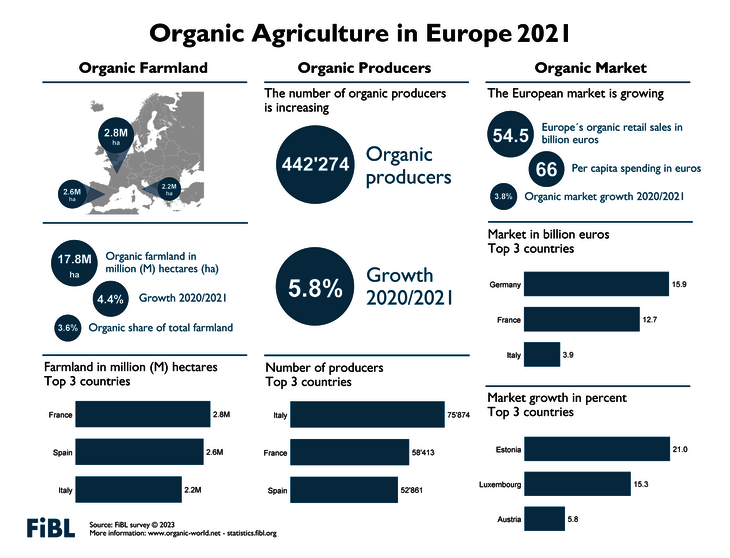2021 was another record year for global organic agriculture. According to the latest FiBL survey on organic agriculture worldwide, organic retail sales increased by 4 billion euros and reached almost 125 billion euros in 2021; organic farmland grew to 76.4 million hectares.
In 2021, the organic market reached almost 125 billion euros – an increase of nearly 4 billion euros or approximately 3 percent.
With 48.6 billion euros, the United States continued to be the world’s leading market, followed by Germany (15.9 billion euros) and France (12.7 billion euros). Swiss consumers spent the most on organic food (425 euros per capita on average), and Denmark continued to have the highest organic market share, with 13 percent of its total food market.
In 2021, 3.7 million organic producers were reported, an increase of 4.9 percent compared to 2020. India remained the country with the most organic producers (1.6 million).

A bit more than 76.4 million hectares were organically managed at the end of 2021, representing a growth of 1.7 percent or 1.3 million hectares compared to 2020. Australia had the largest organic agricultural area (35.7 million hectares), followed by Argentina (4.1 million hectares) and France (2.8 million hectares). Organic farmland area increased in Africa, Asia, Europe and Oceania, while it decreased in the Americas. A bit less than half of the global organic agricultural land was in Oceania (35.9 million hectares). Europe had the second largest area (17.8 million hectares), followed by Latin America (9.9 million hectares).
In 2021, 1.6 percent of farmland around the world was organic. However, many countries have far higher shares: Liechtenstein had the largest organic share of total farmland (40.2 percent), followed by Samoa (29.1 percent) and Austria (26.5 percent). In 20 countries, 10 percent or more of all agricultural land was organic.
Momentum for the organic sector continued to build around the world. Many countries kept up or initiated support activities for organic agriculture, including new action plans or policies aiming to foster growth. This positive trend was mirrored in the increase in fully implemented national regulatory frameworks for organic, which went up to a total of 74 globally.
(Frick, February 14, 2023) In 2021, 17.8 million hectares of farmland in Europe were organic (in the European Union: 15.6 million hectares). With almost 2.8 million hectares, France continued to be the number one country in terms of farmland under organic management, followed by Spain (2.6 million hectares), Italy (2.2 million hectares) and Germany (1.8 million hectares).
Organic farmland increased by almost 0.8 million hectares, which represented an increase of 5.2 percent in the European Union and 4.4 percent in Europe. This increase was slightly lower than in 2020. Compared to 2020, France and Spain reported an increase of 0.23 million hectares and 0.20 million hectares, respectively.

In 2021, organic farmland in Europe constituted 3.6 percent of the total agricultural land. It was 9.6 percent in the European Union. In Europe (and globally), Liechtenstein had the highest organic area share (40.2 percent), followed by Austria, the country with the highest organic share (26.5 percent) in the European Union. Fifteen European countries reported that at least 10 percent of their farmland was organic.
There were more than 440’000 organic producers in Europe and almost 380’000 in the European Union. Italy had the highest number (75’874).
There were 87’676 processors in Europe and 82’500 in the European Union; 7’590 importers were counted in Europe and 6’378 in the European Union. The country with the largest number of processors was Italy (nearly 24‘000), while Germany had the most importers (more than 2’000).
Retail sales in Europe were valued at 54.5 billion euros (46.7 billion in the European Union). The largest market was Germany (15.9 billion euros). The European Union represented the second-largest single market for organic products globally after the United States (48.6 billion euros).
In 2021, consumers in Europe spent 65.7 euros on organic food per person on average (European Union: 104.3 euros). Consumer spending on organic food per capita doubled in the decade 2012-2021. In 2021, Swiss and Danish consumers spent the most on organic food (425 and 384 euros per capita, respectively).
Globally, European countries accounted for the highest share of organic food sales as a percentage of their respective food markets. Denmark had the highest share worldwide, with 13.0 percent in 2021, followed by Austria with a share of 11.6 percent and Luxembourg with 11.0 percent.
In 2021, the European market achieved a growth rate of 3.8 percent (European Union: 3.6 percent). The highest growth was observed in Estonia (+21 percent) and Luxembourg (+15.3 percent), the only countries with double-digit growth in 2021. The pandemic continued to sustain organic markets in many European countries in 2021, but not to the same extent as in 2020, when the market grew by 15 percent.
In 2022, increasing prices for consumer goods cut food spending among some groups. The 2022 data will show the impact on the organic market.